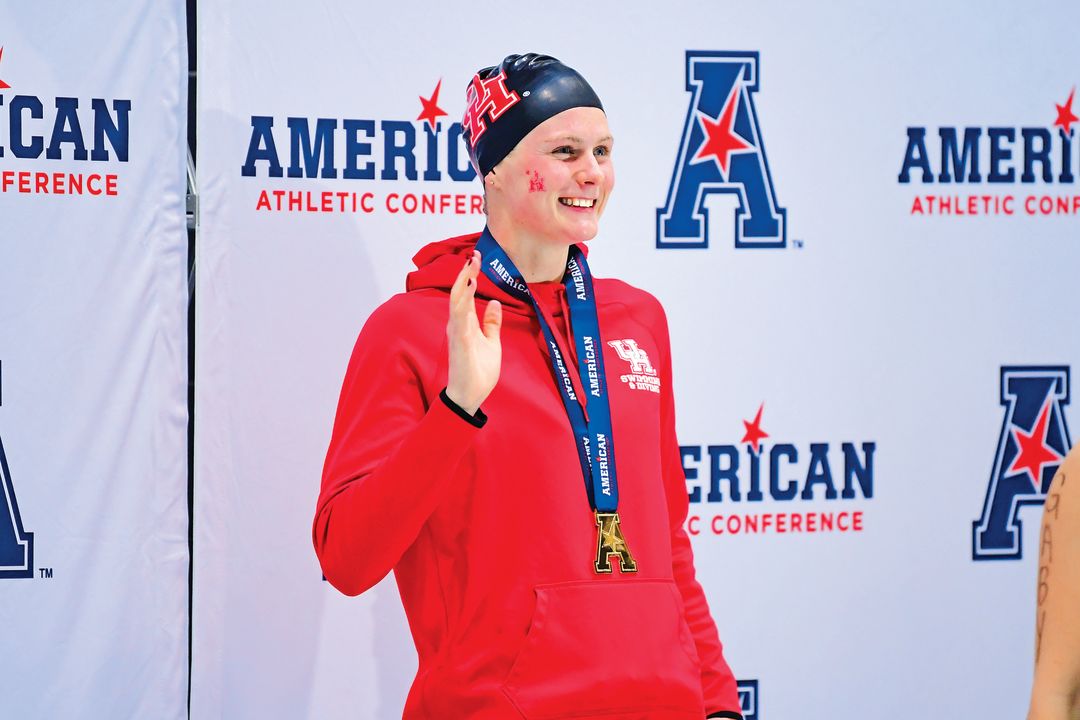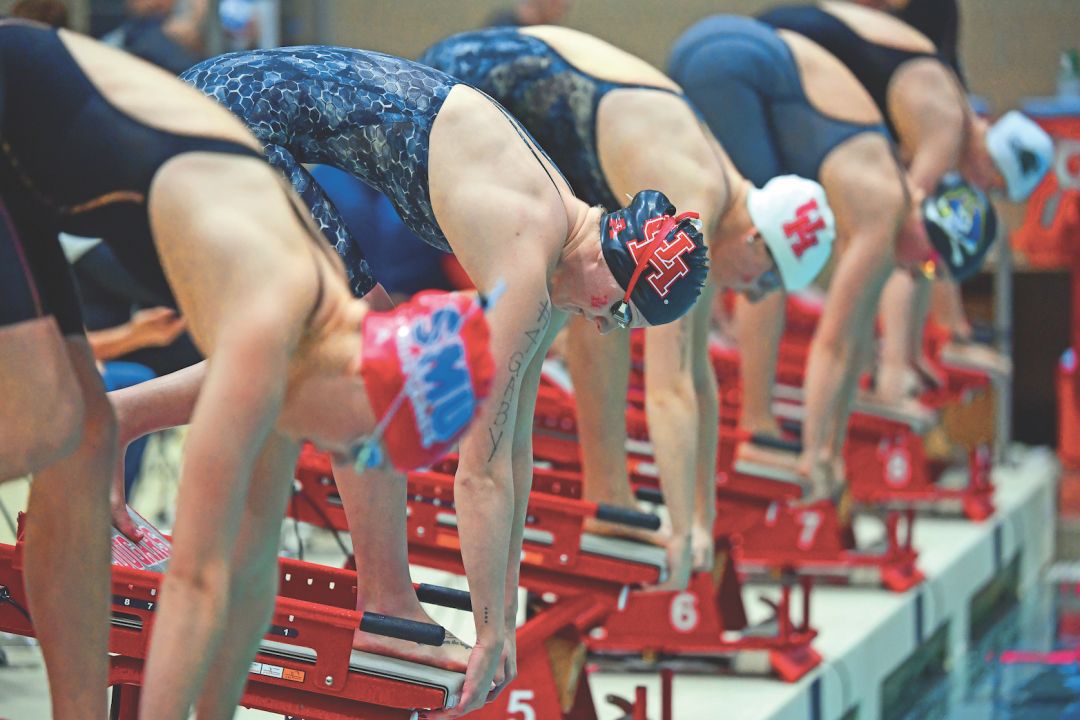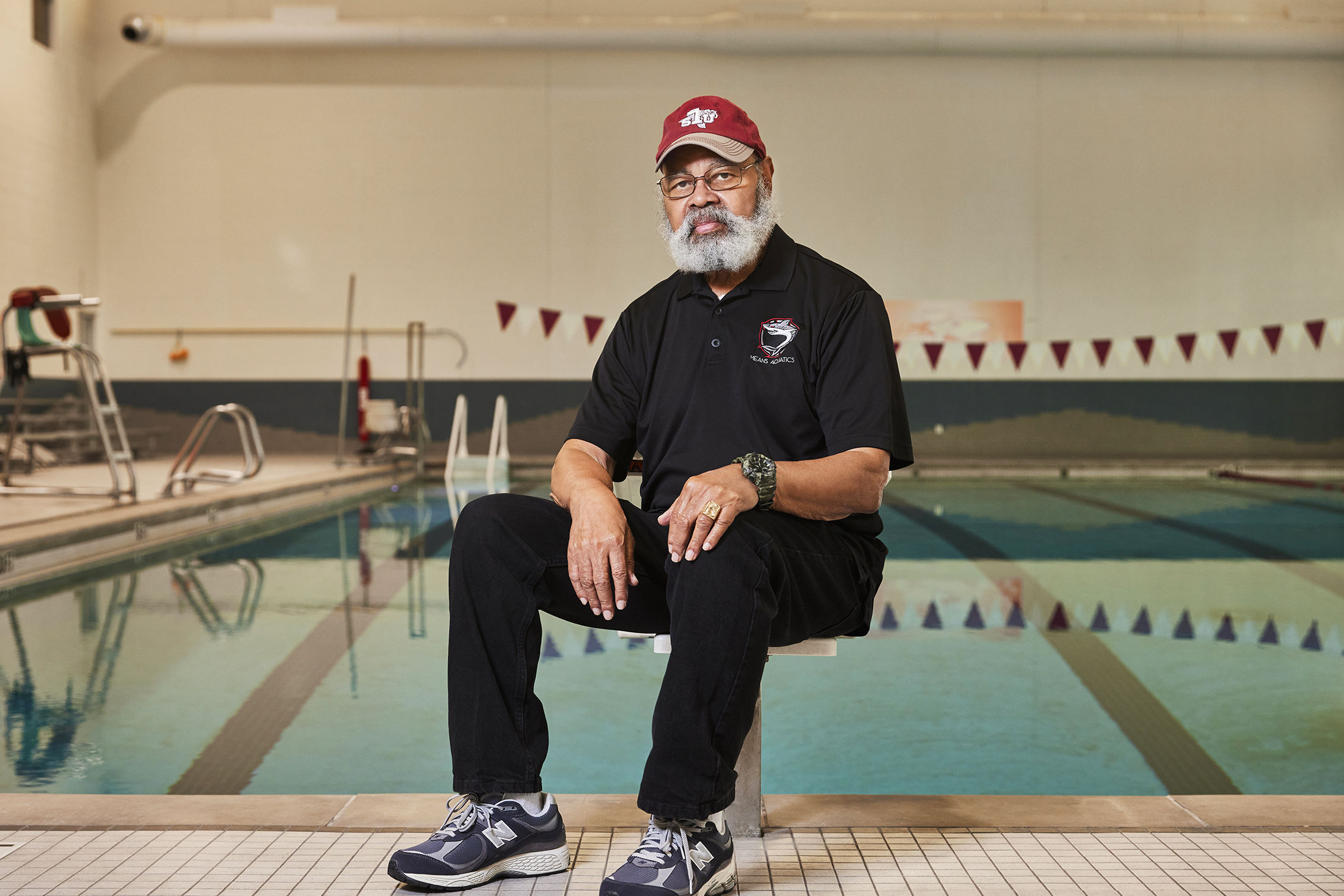How One UH Swimmer Is Keeping Her Olympic Dreams Afloat During a Pandemic

BY THE TIME MYKENZIE LEEHY HIT THE UNIVERSITY OF HOUSTON LAP POOL ON MARCH 12, her sleek, 5’11” frame cutting through the water with X-Acto precision, she was quite aware that plans for sporting events around the globe were crumbling because of the coronavirus. The NBA had suspended its season the day before. March Madness had been called off just that morning.
But the UH junior had heard nothing about her own upcoming meets—the NCAA Division 1 Championships just a week away, where she was to race the 200-yard freestyle along with six teammates in various events, and the 2020 U.S. Olympic Team Trials in a few months, where she’d compete in the 50-meter and 100-meter freestyle—so the 21-year-old put the virus out of her mind and continued training for the peak of what was proving to be the best swimming season of her life.
“We were walking out of the pool when our coach got the text message,” Leehy says now. The NCAA swimming championships would not be held. “It wasn’t even postponed. It was canceled. So it was very hard to process.”
Leehy went back to her apartment near UH’s central campus—eerily dead because of spring break—and waited, completely numb. “There wasn’t anything we could do until the next day,” she says. “My parents got me a flight home, and I’ve been here since.”
She would not compete against the top collegiate swimmers in the country in Athens, Georgia, in March. But despite growing media speculation about the fate of the 2020 Summer Olympics, Leehy still couldn’t imagine that the Tokyo Games, an event she and thousands of other athletes around the world had spent their young lives carefully preparing for, might be canceled, too. After all her years of hard work and sacrifice, how could the Games simply not happen?

Leehy abruptly stopped her Olympic training schedule when COVID-19 forced swimming competitions to shut down.
Leehy grew up in the city of Council Bluffs, Iowa, swimming in club events since age 6 against her older sister, Lauren, who went on to swim at the University of Iowa—“My parents say if it was a 50, down and back,” she says, “we were already getting out of the pool when the swimmers were on the first lap.” She loved that feeling of slicing through the water even then. Growing up, she glued herself to the TV every four years watching the top swimmers in the world compete in the Summer Olympics.
At 12 Leehy got to be a volunteer at the 2012 U.S. Olympic Team Trials, held 10 minutes from her home, just over the state line in Omaha, Nebraska. She trotted back and forth, carrying swimmers’ warmups in a basket to their lane, and wiped down their starting blocks in awe, soaking up every minute of the experience. “I remember meeting Matt Grevers and Michael Phelps and Summer Sanders—she was a commentator,” Leehy says. “Just being around that atmosphere, it’s something that I’ve always wanted to achieve.”
And achieve she did: Within two years she’d won her first of eight All-American honors and was counted among the fastest 100 high school swimmers in the nation. By her sophomore year of high school, she’d broken the Iowa state record for the 100-yard free, in a time that still stands. By her sophomore year swimming for UH (2018–19), she qualified for the Olympic Trials in the 100-meter freestyle. Now nationally ranked as one of the top 25 fastest swimmers in the event, Leehy was ready to go head to head with her competition in Omaha this June, intent on securing a place on the Olympic team. “I was mentally prepared for the trials this year,” she says. “I had all these plans.”
Instead she found herself back home in Iowa shortly after the NCAA meet had been called off, staring out at the frigid pool in her parents’ backyard—no word on whether the Trials would go on or where she could possibly train.
Leehy wasn’t alone. Of the roughly 600 Americans expected to head to the 2020 Tokyo Games, only 76 had already qualified for Team USA in their respective sports (surfing, sailing, and table tennis among them) by mid-March—about 57 percent of 11,000 Olympians worldwide had qualified. Many waited anxiously for word on what, if anything, they could do to resume their rigorous training schedules. That was proving to be difficult, if not impossible: as the COVID-19 epidemic spread across the country, public and private gyms, swimming pools, and training facilities all shut down.
Soon people were questioning whether the Games should be held at all. Officials with USA Swimming, the federation that represents some 400,000 athletes, emerged as a leading voice for the postponement of the 2020 Summer Olympics, releasing a letter on March 20 to the US Olympic & Paralympic Committee urging it to consider athletes’ health and safety: Pressing forward amidst the global health crisis this summer is not the answer, wrote its CEO, Tim Hinchey III. Four days later the International Olympic Committee and Japan formally rescheduled the Tokyo Games to take place from July 23 to August 8, 2021.
Having the official decision came as a relief, but also, as retired swimmer Michael Phelps called it, “a total bamboozle.”
The implications are certainly substantial. In addition to the emotional stress Leehy and other athletes have had to contend with, the cancelation costs everyone quite a bit of money. Japan is estimated to have lost somewhere between $2 billion and $6 billion dollars in Olympics-related revenue. The Games being pushed to next year may cost Team USA roughly $200 million in media contracts alone—and many athletes depend on their federations’ cuts of those revenues to survive.
But the alternatives? To carry on as normal in the face of a global pandemic—or worse, to call off the Olympics altogether? “Let’s not even go there,” says three-time Canadian Olympian Ken Armstrong. The famed diving champion now coaches three diving hopefuls in The Woodlands, including Laura Wilkinson, who took the gold at the Sydney Games in 2000 and has made an astonishing return to the 10-meter platform at 41. Armstrong says this moment—the collapse of all that tension and anticipation leading up to the Games—reminds him of the 1980 Summer Olympics in Moscow, the only time American (and Canadian) athletes have ever skipped the event since the modern Olympics were first held in 1896. The U.S. and 65 other countries sat out that year in protest of the Soviet invasion of Afghanistan, and Armstrong was among the athletes who didn’t get to compete. “It wasn’t very fun,” he says wryly. “Fourteen years was how long I’d trained to get to that point.”

For now Houston’s own Olympic hopefuls—including more than a dozen athletes in diving, swimming, boxing, fencing, track and field, and gymnastics—are trying to stay positive and fit, even if that means getting creative. On Instagram UH alumnus and track star Cameron Burrell sprints up his home stairs, while famed gymnast and multiple Olympic champion Simone Biles levitates on miniature parallel bars in her living room. Fencing champs train on an outdoor track in Spring Branch. Armstrong’s team logs onto Zoom daily for two hours of guided diving training and lectures on stress management from guest speakers like Greg Louganis, the only man ever to sweep the diving events in consecutive Olympics.
Leehy does much the same, meeting with her swim team on Zoom—they’re currently reading The Power of a Positive Team by John Gordon—and cross training and weightlifting at home to stay in the best possible shape. In season she’d typically be in the pool for workouts two to three times a day, with one grueling three-hour session on the weekend. Right now, though, she has no idea when she’ll be able to even get in the water again. At the time we spoke, temperatures were still in the 40s in Council Bluffs, and the backyard pool is so small. “I do have a wetsuit,” she laments.
Still, she’s adjusting to her new reality of online geology and kinesiology classes (she’s a sports administration major) and turning her focus to 2021, grateful she can afford to wait a year. One of her teammates, a senior, decided to move on and not pursue the Trials next year at all. While Leehy knows that she’ll have to do the same eventually, she is relieved that her races earlier this year aren’t going to be her last. “At some point in my life, I’m going to have to walk into the real world and get a real job,” she says. “But I at least have a chance next year to come back and hopefully be better.”
The competition will be fierce. American swimmers brought home 33 medals at the 2016 Rio Games—far more than even runner-up Australia, which brought in 10—and USA Swimming is allowing athletes to continue qualifying for the 2021 Trials if they post an exceptionally fast race time. But Leehy isn’t concerned. “I think I have a chance to pop a time, be top four, and make the team,” she says.
Hopefully she will have that opportunity. Ominously, in late April, Japanese medical officials announced that it would be “exceedingly difficult” to host the Games if a coronavirus vaccine has not yet been developed. Now, even as they recalibrate to prepare for next year's Games the possibility of another delay hangs over the heads of Leehy and all would-be Olympians.
But Leehy isn’t dwelling on that. Instead she’s already visualizing races that lie ahead and controlling what she can in terms of her mental and athletic fitness. That’s the only way to move forward in the midst of so much unpredictability, she says. “I don’t know if ‘crazy’ is the word,” Leehy says. “But nobody ever thought this would be happening.”




